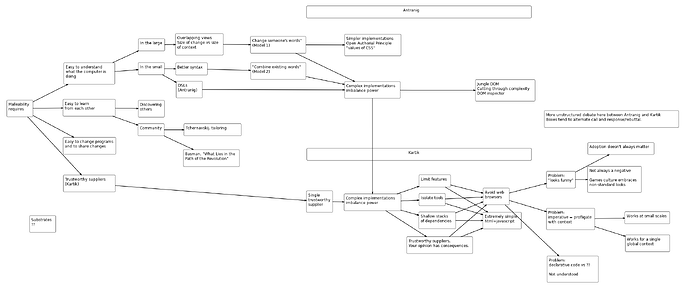Yes, this seems to be the way.
I find neither trees nor linear threads quite suit all purposes. So I sometimes create custom views of conversations. Here’s one I just made for our exchanges, in case you find it useful. At least in the draft view it looks like Discourse doesn’t downsample it to uselessness, so hopefully you’ll be able to open the image in a new tab to read it. I’ll also include the “source code” I used to create it using snap.love. The text looks crisper if you zoom in a little bit.
kartik-antranig
{ "next" : 38, "nodes" : {
"a": {"type":"text","h":75,"width":120,"x":8.25,"y":-4,"id":"a","data":["Single","trustworthy","supplier"],"margin":0,"outgoing_edges":["b"],"incoming_edges":["l"],"w":120}
,"b": {"type":"text","h":50,"width":283.75,"x":209,"y":12,"id":"b","data":["Complex implementations imbalance power"],"margin":0,"outgoing_edges":["c","d","g","h"],"incoming_edges":["a","w"],"w":283.75}
,"ba": {"type":"text","h":50,"width":276.25,"x":-291,"y":-828.58333333333,"data":["Change someone's words\"","(Model 1)"],"w":276.25,"id":"ba","margin":0,"outgoing_edges":["w","be"],"incoming_edges":["z"]}
,"bb": {"type":"text","h":50,"width":275,"x":-289.75,"y":-688.58333333333,"data":["\"Combine existing words\"","(Model 2)"],"w":275,"id":"bb","margin":0,"outgoing_edges":["w"],"incoming_edges":["q"]}
,"bc": {"type":"text","h":25,"width":286.25,"x":-646,"y":-362.33333333333,"data":["Tchernavskij, tailoring"],"w":286.25,"id":"bc","margin":0,"outgoing_edges":[],"incoming_edges":["t"]}
,"bd": {"type":"text","h":50,"width":278.75,"x":-648.5,"y":-223.58333333333,"data":["Basman, \"What Lies in the Path of the Revolution\""],"w":278.75,"id":"bd","margin":0,"outgoing_edges":[],"incoming_edges":["t"]}
,"be": {"type":"text","h":75,"width":281.25,"x":211.5,"y":-839.83333333333,"data":["Simpler implementations","Open Authorial Principle","\"values of CSS\""],"w":281.25,"id":"be","margin":0,"outgoing_edges":[],"incoming_edges":["ba"]}
,"bf": {"type":"text","h":50,"width":135,"x":1289,"y":-108.58333333333,"data":["Problem:","\"looks funny\""],"w":135,"id":"bf","margin":0,"outgoing_edges":["bg","bh"],"incoming_edges":["e"]}
,"bg": {"type":"text","h":100,"width":267.5,"x":1509,"y":-134.83333333333,"data":["Not always a negative","","Games culture embraces non-standard looks"],"w":267.5,"id":"bg","margin":0,"outgoing_edges":[],"incoming_edges":["bf"]}
,"bh": {"type":"text","h":25,"width":333.75,"x":1510.25,"y":-262.33333333333,"data":["Adoption doesn't always matter"],"w":333.75,"id":"bh","margin":0,"outgoing_edges":[],"incoming_edges":["bf"]}
,"bi": {"type":"text","h":75,"width":238.75,"x":1289,"y":88.916666666667,"data":["Problem:","imperative = profligate with context"],"w":238.75,"id":"bi","margin":0,"outgoing_edges":["bj","bk"],"incoming_edges":["e"]}
,"bj": {"type":"text","h":25,"width":220,"x":1707.75,"y":107.66666666667,"data":["Works at small scales"],"w":220,"id":"bj","margin":0,"outgoing_edges":[],"incoming_edges":["bi"]}
,"bk": {"type":"text","h":50,"width":217.5,"x":1710.25,"y":231.41666666667,"data":["Works for a single global context"],"w":217.5,"id":"bk","margin":0,"outgoing_edges":[],"incoming_edges":["bi"]}
,"bl": {"type":"text","h":100,"width":253.75,"x":1292.75,"y":343.91666666667,"data":["Problem:","declarative code vs ??","","Not understood"],"w":253.75,"id":"bl","margin":0,"outgoing_edges":[],"incoming_edges":["e"]}
,"c": {"type":"text","h":25,"width":149,"x":609,"y":-89,"id":"c","data":["Limit features"],"margin":0,"outgoing_edges":["e","f"],"incoming_edges":["b"],"w":149}
,"d": {"type":"text","h":25,"width":120,"x":609,"y":10,"id":"d","data":["Isolate tools"],"margin":0,"outgoing_edges":["e","f"],"incoming_edges":["b"],"w":120}
,"e": {"type":"text","h":50,"width":120,"x":951,"y":-19,"id":"e","data":["Avoid web","browsers"],"margin":0,"outgoing_edges":["bf","bi","bl"],"incoming_edges":["c","d","g","h"],"w":120}
,"f": {"type":"text","h":50,"width":185,"x":950,"y":110,"id":"f","data":["Extremely simple html+javascript"],"margin":0,"outgoing_edges":[],"incoming_edges":["c","d","g","h"],"w":185}
,"g": {"type":"text","h":50,"width":177,"x":608,"y":109,"id":"g","data":["Shallow stacks","of dependencies"],"margin":0,"outgoing_edges":["e","f"],"incoming_edges":["b"],"w":177}
,"h": {"type":"text","h":50,"width":331,"x":544,"y":241,"id":"h","data":["Trustworthy suppliers.","Your opinion has consequences."],"margin":0,"outgoing_edges":["e","f"],"incoming_edges":["b"],"w":331}
,"i": {"type":"text","h":25,"width":1179,"x":10,"y":-231,"data":[" Kartik"],"w":1179,"id":"i","margin":0,"outgoing_edges":[],"incoming_edges":[]}
,"j": {"type":"text","h":25,"width":1180,"x":8.75,"y":-991.33333333333,"data":[" Antranig"],"w":1180,"id":"j","margin":0,"outgoing_edges":[],"incoming_edges":[]}
,"k": {"type":"text","h":50,"width":120,"x":-1591.4166666667,"y":-488.58333333333,"data":["Malleability requires"],"w":120,"id":"k","margin":0,"outgoing_edges":["l","m","n","y"],"incoming_edges":[]}
,"l": {"type":"text","h":50,"width":257.5,"x":-1289.75,"y":-88.166666666667,"data":["Trustworthy suppliers","(Kartik)"],"w":257.5,"id":"l","margin":0,"outgoing_edges":["a"],"incoming_edges":["k"]}
,"m": {"type":"text","h":50,"width":259.16666666667,"x":-1291.4166666667,"y":-492.33333333333,"data":["Easy to learn","from each other"],"w":259.16666666667,"id":"m","margin":0,"outgoing_edges":["s","t"],"incoming_edges":["k"]}
,"n": {"type":"text","h":75,"width":252.5,"x":-1287.25,"y":-688.16666666667,"data":["Easy to understand what the computer is doing"],"w":252.5,"id":"n","margin":0,"outgoing_edges":["o","p"],"incoming_edges":["k"]}
,"o": {"type":"text","h":25,"width":120,"x":-888.5,"y":-816.08333333333,"data":["In the large"],"w":120,"id":"o","margin":0,"outgoing_edges":["z"],"incoming_edges":["n"]}
,"p": {"type":"text","h":25,"width":120,"x":-889.75,"y":-688.58333333333,"data":["In the small"],"w":120,"id":"p","margin":0,"outgoing_edges":["q","r"],"incoming_edges":["n"]}
,"q": {"type":"text","h":25,"width":150,"x":-689.75,"y":-687.33333333333,"data":["Better syntax"],"w":150,"id":"q","margin":0,"outgoing_edges":["bb"],"incoming_edges":["p"]}
,"r": {"type":"text","h":50,"width":120,"x":-687.25,"y":-589.83333333333,"data":["DSLs","(Antranig)"],"w":120,"id":"r","margin":0,"outgoing_edges":["w"],"incoming_edges":["p"]}
,"s": {"type":"text","h":50,"width":120,"x":-889.75,"y":-487.33333333333,"data":["Discovering","others"],"w":120,"id":"s","margin":0,"outgoing_edges":[],"incoming_edges":["m"]}
,"t": {"type":"text","h":25,"width":120,"x":-891,"y":-362.33333333333,"data":["Community"],"w":120,"id":"t","margin":0,"outgoing_edges":["bc","bd"],"incoming_edges":["m"]}
,"u": {"type":"text","h":50,"width":697.5,"x":1277.75,"y":-432.33333333333,"data":["More unstructured debate here between Antranig and Kartik","Boxes tend to alternate call and response/rebuttal."],"w":697.5,"id":"u","margin":0,"outgoing_edges":[],"incoming_edges":[]}
,"v": {"type":"text","h":50,"width":120,"x":-1470.1666666667,"y":128.08333333333,"data":["Substrates??"],"w":120,"id":"v","margin":0,"outgoing_edges":[],"incoming_edges":[]}
,"w": {"type":"text","h":50,"width":277.5,"x":211.5,"y":-587.33333333333,"data":["Complex implementations","imbalance power"],"w":277.5,"id":"w","margin":0,"outgoing_edges":["x","b"],"incoming_edges":["r","bb","ba"]}
,"x": {"type":"text","h":75,"width":298.75,"x":910.25,"y":-597.33333333333,"data":["Jungle DOM","Cutting through complexity","DOM inspector"],"w":298.75,"id":"x","margin":0,"outgoing_edges":[],"incoming_edges":["w"]}
,"y": {"type":"text","h":50,"width":262.5,"x":-1291,"y":-289.83333333333,"data":["Easy to change programs","and to share changes"],"w":262.5,"id":"y","margin":0,"outgoing_edges":[],"incoming_edges":["k"]}
,"z": {"type":"text","h":75,"width":235,"x":-691,"y":-843.58333333333,"data":["Overlapping views","Size of change vs size of context"],"w":235,"id":"z","margin":0,"outgoing_edges":["ba"],"incoming_edges":["o"]}
}}
Ok, now I can respond further, and hopefully it’ll be apparent which box in the map above my responses correspond to.

